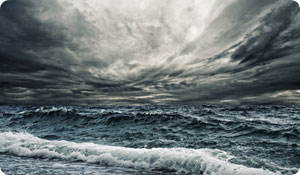
It's normal to feel under the weather every once in a while. But if you suffer from mold allergies, these words may have taken on deeper meaning in recent months. Weather disturbances in different regions have left behind a trail of health-related problems.
Weather and Allergies: The Mold Problem
Global warming has led to more dangerous weather conditions in the United States, including more hurricanes and tropical storms, heavier snow fall, and other extreme weather conditions. If you live in an area affected by any of these situations, long after the storm has passed you could still be left grappling with related water damage, flooding, and mold allergies.
What You Should Know About Mold Allergies
When there's dampness in your home, this enables mold (a type of fungi) spores to breed and grow. Therefore, what starts out as a small problem from water damage can quickly become much more serious. In fact, it only takes a day or two for mold spores to reproduce in the right environment. Some places where mold may flourish is beneath your floorboards, behind wallpaper, and inside your sheetrock and ceiling tiles. It can also grow on your furniture and clothing, too. Often you won't notice the mold, which gives it a chance to take hold. As the mold reproduces, it releases spores into the air. When you inhale these spores, this can trigger your immune system into overdrive and make you feel pretty miserable.
Symptoms of a Mold Allergy
Some mold allergy symptoms include itchy throat, ears, and eyes, nasal symptoms, coughing, difficulty breathing, and headaches. If you're prone to allergic asthma, exposure to mold can also trigger this chronic respiratory condition.
Fighting Back Against Mold, Weather, and Allergies
The best way to fight against mold allergies is to identify any areas that could be affected by mold in your home and your workplace and then take steps to get rid of it completely. Just remember that it's important to do this carefully, since coming in contact with the mold during this process can also worsen your mold allergy symptoms. Ideally, you should hire a professional trained in mold removal to handle the clean up, or ask family members or friends for help. If you must do it yourself, though, be sure to put on a mask over your mouth, and wear gloves and goggles to minimize your contact.
Here are some tips to help you wash away mold allergies:
- Dry out and cool down any wet areas, since the wetness and humidity provide a breeding ground for the mold to grow quickly.
- Remove wet furniture or other items immediately.
- Dry clean wet clothing and soft items.
- Throw away anything that can't be thoroughly cleaned.
- Scrub contaminated areas with a mixture of warm water and detergent.
- Dry surfaces thoroughly once they are clean.
- Remember that time is of the essence after a flood. The longer you wait to dry wet areas, the more likely it is that mold will have a chance to grow.
If you do suffer a reaction from mold during the cleanup, antihistamines may provide relief. When your discomfort is severe, you should also talk to your allergist about using an oral or nasal form of a steroid. If the effect of weather on your allergies becomes a chronic problem, your doctor may also recommend trying immunotherapy to desensitize your body to mold and other allergens.
Sources:
"Emergency Preparedness and Response." Centers for Disease Control and Prevention (CDC). CDC.gov, 25 June 2007. Web. 5 Oct. 2011.
"Global Warming and Hurricanes." National Wildlife Federation (NWF). NWF.org, n.d. Web. 5 Oct. 2011.
"Science News: Allergy Expert Has Advice For Flood Victims." Science Daily. Washington University in St. Louis, 20 June 2008. Web. 6 Oct. 2011.
"What Can I Do about Mold in My Home?" Georgia Department of Human Resources Division of Public Health Environmental Health and Injury Prevention Branch. U.S. Environmental Protection Agency (EPA), n.d. Web. 9 Oct. 2011.





